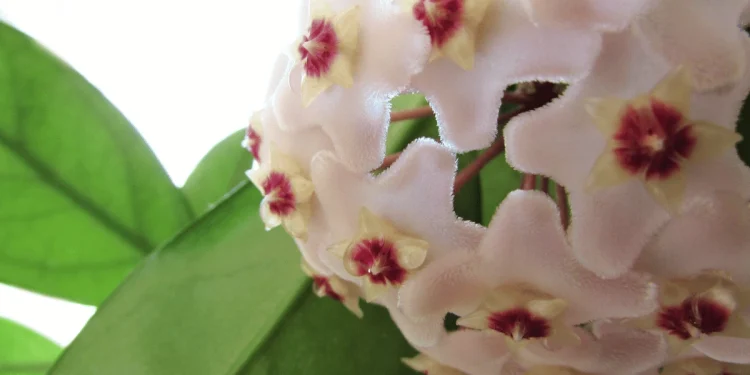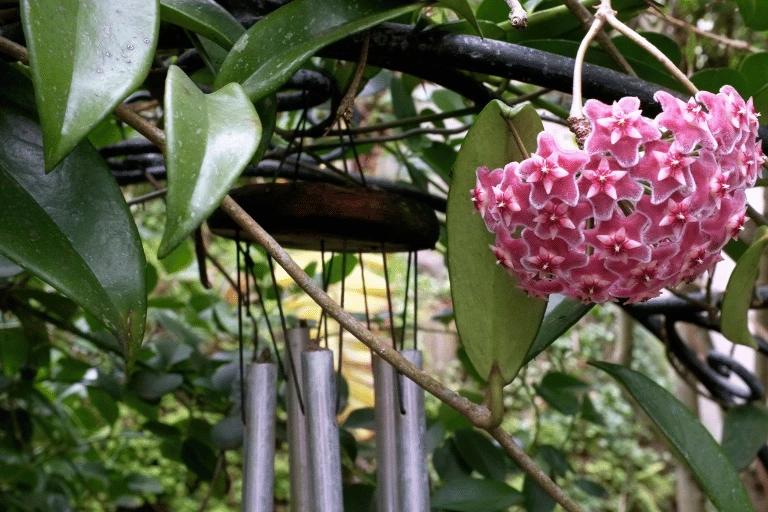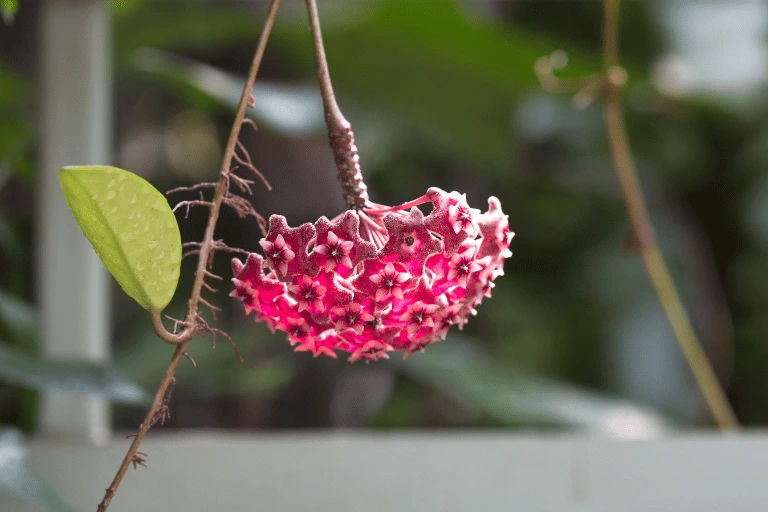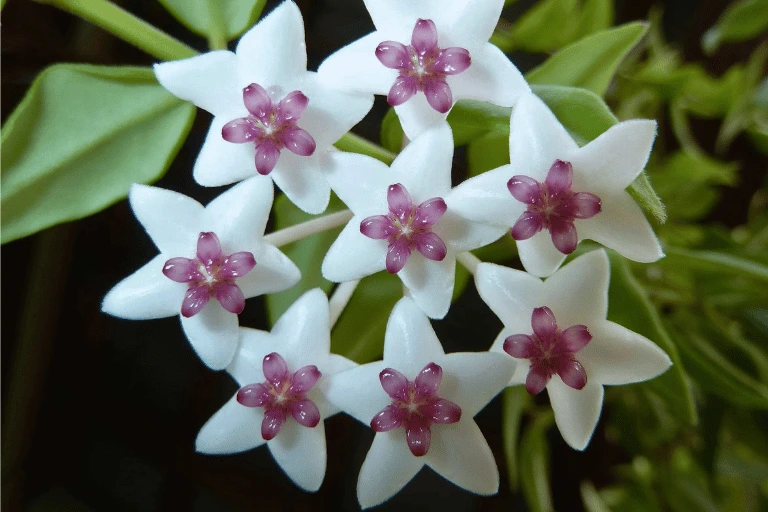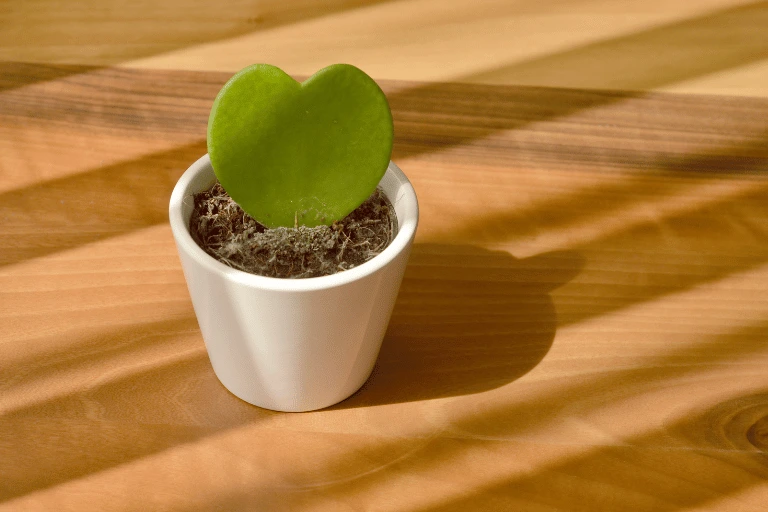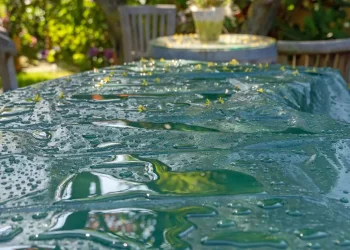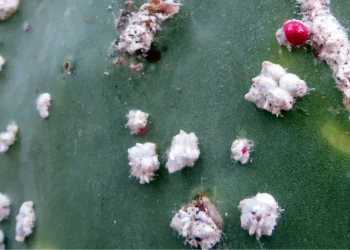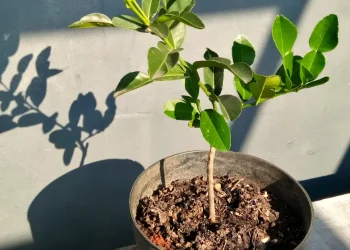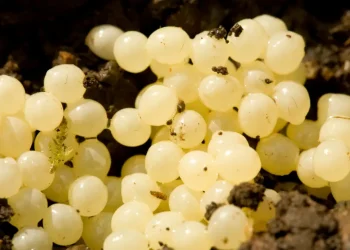When I saw Hoya in the gardening store the other day, I knew that was something that needed to decorate my house. So I got one, and then a few weeks after another one, and one more in three.
Hoyas are members of the Asclepiadaceae family, also known as the milkweed family, and they hail from tropical regions such as Asia or Australia. With over 200 species in existence, each with its own unique characteristics and blooming tendencies, you truly can make your home special.
Hoyas are commonly known as a Wax Plant. So if you see this name somewhere, you will know what you are looking at. They got the nickname “Wax Plant” because their leaves have a thick, glossy texture reminiscent of a waxy surface. It developed as a protective layer that helps the plant retain moisture, reducing water loss through the leaves and preventing dehydration.
Depending on the species of Hoya, the flowers may last from a few days to a few weeks. Apart from the type of plant you have, the blooming period and the lifespan of the flowers also depend on environmental factors, like lighting, water, or temperature. But we’ll discuss all that later in this article.
So without further ado, slip into your favorite observing outfit, and let’s find out how often Hoyas bloom and, once they do, how long Hoya’s flowers last.
The Ideal Conditions for Hoya Plant to Bloom
When it comes to the blooming frequency of Hoyas, the species itself plays a significant role. Different Hoya species have different blooming schedules. Some species are known for their frequent and abundant blooms, while others may be more reserved in their flowering habits.
But the species alone is not the sole determining factor. There are various other elements that come into play, influencing how often will your Hoya bloom.
Factors such as lighting, temperature, humidity, watering practices, and nutrient availability can all impact that. So, let’s take a look at each of these factors individually.
Lighting
It’s no surprise that Hoyas like a lot of natural light, as they originate from lush tropical regions.
Hoyas thrive in bright, indirect light, replicating the dappled sunlight they would receive in their native habitats. So placing them near a window that allows filtered sunlight to stream in is the way to go.
But be careful. Like most indoor plants, you don’t want your Hoyas to stay in direct sunlight for too long as It can scorch the leaves. Scorched leaves not only diminish the aesthetic appeal of the plant but can also affect its overall health and vitality. It reduces the plant’s ability to photosynthesize and produce enough energy to thrive. Leading to slowed growth, development, and also a blooming frequency.
Temperature & Humidity
Once again, considering where Hoyas originate from, these plants have a preference for warm and humid environments.
The right temperature range typically between 60°F (15°C) and 80°F (27°C). They will be able to withstand higher temperatures than that, even around 90°F (35°C) would be fine. But be careful about the lower value of the range.
I often get questions about putting plants on radiators or under air conditioners. That’s never a good idea. First, radiators emit high levels of heat that are then distributed around the room. But the close surroundings of the radiator get very hot, and once you turn it off, it will get very cold in contrast. Not to mention that you are heating the plant solely from underneath, heating just the soil. And the situation is similar with air conditioners.
So just because Hoyas can withstand higher temperatures, don’t place them on radiators.
Additionally, Hoyas appreciate higher humidity levels that mimic their natural habitats. Adequate humidity helps keep their leaves lush and prevents them from drying out. If the air is too dry, it may hinder the formation of flower buds or cause them to drop prematurely. Simply misting your plants a couple of times a week should do the work.
Watering
Hoyas simply love water and do not like to dry out at all. But it’s important to strike the right balance and keep a consistent level of moisture without overwatering.
What is the right balance? It would be boring if there was a simple answer, right? How much water a Hoya plant needs depends on several factors.
Without diving into many specifics, you should keep a consistent level of moisture without overwatering and without letting the soil dry out. Simply let the top layer of soil dry out between watering. In most cases, watering your Hoya every 7 to 10 days is a good starting point. During hot summer days, this can be taken down even to every four days. And remember that underwatering is a lot better for the plant than overwatering.
If you want to get a lot scientific and find out about all the variables there are, check out my guide on How to Water Hoya Plant.
Available Nutrients in the Soil
You can nail every other factor perfectly, but if your Hoya lives in poor soil, it won’t have the important nutrients required for healthy growth.
Opt-in for well-draining soil rich in light materials such as coco coir, peat moss, or perlite. To provide your Hoyas with all the nutrients they need, consider using a well-balanced fertilizer formulated specifically for these types of plants.
But be careful with the application. Always follow the label to avoid over-fertilization, which can lead to salt buildup and damage the roots.
How Often do Hoyas Bloom
As we already discussed, the frequency of Hoya blooming can vary depending on the species and other factors influencing the overall health of the plant.
While some Hoyas are known for their ability to produce flowers multiple times a year, on average many Hoya species tend to bloom only once or twice a year, typically during the warmer months when conditions are favorable.
However, there are several Hoya species known for their irregular blooming intervals, or intervals that are a lot more dependent on the environment. For instance, Hoya Kerrii doesn’t bloom until they are about 3 years old. Or Hoya Lacunosa that can bloom all year round if it is in an ideal environment.
How Long does Hoyas Flowers Last
Once you get your Hoya to bloom, the flowers are very nice to look at. But unfortunately, the flowers won’t last forever. On average, Hoya flowers have a lifespan of several days to a couple of weeks.
It all again comes down to two factors – firstly, the species of Hoya, and secondly, the environmental condition in which the plant grows.
Some species, like Hoya multiflora or Hoya shepherdii, bloom and last longer, usually from two to three weeks. Whereas some species like Hoya imperialism or Hoya lucunosa flowers only last for a few days at max.
However, each individual flower within a Hoya cluster may not bloom simultaneously. As older flowers fade and wither, new buds continue to emerge. So you may enjoy the flowers for a lot longer.
Hoya Varieties and their Blooming Patterns
Every Hoya species is special, they have different flowering habits, last for different times, and the flowers also can form into many different shapes and colors. So to bring you closer to the action, I chose 5 different species I really like, and we’ll discuss the look of the species and also how often and for how long it blooms.
Hoya Carnosa is the most common, classic Hoya species that typically bloom in the spring or summer that forms clusters of star-shaped flowers. The flowers can last for several days to a couple of weeks. During that time, you will smell their typical, sweet fragrance everywhere.
Hoya Pubicalyx is known for its dark green foliage and stunning flowers that can bloom multiple times throughout the year. These flowers can showcase a range of colors, from deep purple to pink, but last only several days before gradually fading away.
Hoya Australis is not a typical Hoya with rich foliage and full clusters of flowers. It is usually a very small, potted plant resembling succulents. It tends to bloom in the warmer months, such as spring and summer, with creamy white flowers lasting for a week or even more, filling the air with a delicate, sweet scent.
Hoya Bella is another smaller type of Hoya, but with all the prettier flowers that bloom in the warmer months, showcasing clusters of creamy-white blooms with a maroon center. The flowers can last for around a week.
Hoya Kerrii, also known as the Sweetheart Hoya, really captures hearts with its heart-shaped leaves and occasional bursts of fragrant flowers. It tends to bloom sporadically throughout the year, surprising us with small, white blossoms that can last for several days.
How to Take Care of Hoya After it Blooms
Congratulations on getting your Hoya plant to flower. But what now?
The fact that your plant blooms does not necessarily mean that you have to change anything. However, maintaining flowers costs a lot of energy for the plant. So it’s important to not make any significant changes to your caring routine during that time. Additionally, here are some essential care tips to follow:
- Firstly, never remove any vines from the plant. Post-blooming is a great time to shape your Hoya. But never remove entire vines, as Hoya will always flower from the same vines. This, of course, doesn’t apply if the vine is unhealthy or damaged.
- Remove dry flowers or leaves from your Hoya. These withered parts can still take a lot of energy from the plant that can be used in another part to produce more flowers or to grow bigger and healthier.
- Provide optimal light, temperature, and watering. As was already mentioned, your Hoya needs it now more than ever.
- Do not fertilize during the blooming period. But after the blooming phase is over, you can resume regular fertilization.
Before you go…
I bet that the majority of gardeners got their Hoya because of their beautiful flowers. Most Hoya plants bloom once or twice a year, and you surely don’t want to miss that. And for the rest of the year, there’s one other undeniable advantage that Hoyas brings to your home. I have taken the time to find available research about Hoya’s ability to purify air. Make sure to check out what I found! Spoiler alert: They do really have the ability to purify air, but it’s not that great…

